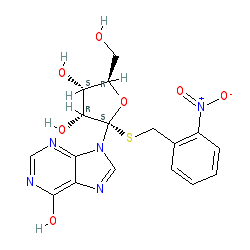GtoPdb is requesting financial support from commercial users. Please see our sustainability page for more information.
|
Abbreviated name: NBMPR
Synonyms: NBTI | nitrobenzylthioinosine
Compound class:
Synthetic organic
Comment: NBMPR is a equilibrative nucleoside transporter 1 (ENT1) inhibitor. Alternative isomeric structures are reported including the (2R,3S,4R,5R) form that has PubChem CID 65407. NBMPR is chemically distinct from dilazep and crystallisation and mutagenesis studies show that these two inhibitors utilise different binding mechanisms at ENT1 [6]. The crystal structure of ENT1 in complex with NBMPR is deposited in the Protein Data Bank under accession code 6OB6 [6]..
Ligand Activity Visualisation ChartsThese are box plot that provide a unique visualisation, summarising all the activity data for a ligand taken from ChEMBL and GtoPdb across multiple targets and species. Click on a plot to see the median, interquartile range, low and high data points. A value of zero indicates that no data are available. A separate chart is created for each target, and where possible the algorithm tries to merge ChEMBL and GtoPdb targets by matching them on name and UniProt accession, for each available species. However, please note that inconsistency in naming of targets may lead to data for the same target being reported across multiple charts. ✖ |
|
|||||||||||||||||||||||||||||||||||
| Selectivity at transporters | ||||||||||||||||||||||||||||||||||
| Key to terms and symbols | Click column headers to sort | |||||||||||||||||||||||||||||||||
|
||||||||||||||||||||||||||||||||||
| Targets where the ligand is described in the comment field | |
| Target | Comment |
| Equilibrative nucleoside transporter 1 | SLC29A1 (ENT1) has 100-1000-fold lower affinity for nucleobases as compared with nucleosides [7]. The affinities of draflazine, dilazep, KF24345 and dipyridamole at SLC29A1 transporters are species dependent, exhibiting lower affinity at rat transporters than at human transporters [3-4]. Dilazep and nitrobenzylmercaptopurine ribonucleoside have distinct but overlapping binding domains in the SLC29A1 crystal structure [6]. The loss of SLC29A1 activity in SLC29A1-null mice has been associated with a hypermineralization disorder similar to human diffuse idiopathic skeletal hyperostosis [5]. Lack of SLC29A1 also results in the Augustine-null blood type [1]. SLC29A1 forms homodimers and heterodimers (with SLC29A2) [2]. |






